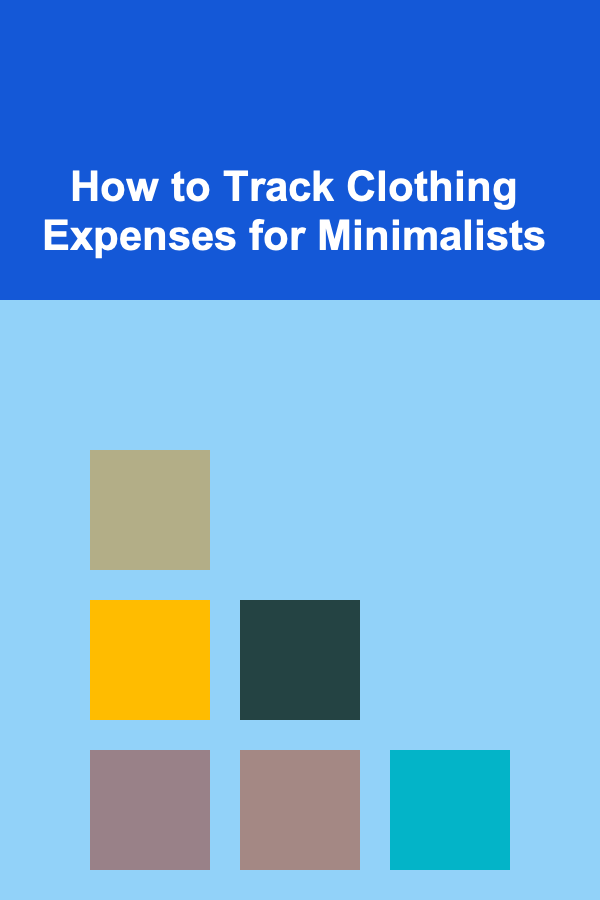
How to Track Clothing Expenses for Minimalists
ebook include PDF & Audio bundle (Micro Guide)
$12.99$10.99
Limited Time Offer! Order within the next:

Minimalism is a lifestyle centered around reducing clutter and only keeping the things that truly add value to your life. For many, this approach extends to every aspect of their daily existence, including their wardrobe. Minimalists aim to cultivate a wardrobe that is both practical and intentional, avoiding overconsumption and unnecessary purchases. However, this philosophy raises the question: how can you track clothing expenses for minimalists while staying true to the values of simplicity and intentionality?
Tracking clothing expenses doesn't mean you have to adopt a complex or burdensome system. Instead, it's about fostering awareness of your spending habits, ensuring that every purchase aligns with your minimalist values, and maintaining a budget that allows for future clothing investments without guilt or excess.
This article will explore how minimalists can track their clothing expenses effectively while adhering to a minimalist approach. We'll cover everything from setting a budget to finding the right tools and strategies to keep track of spending, all while ensuring that your clothing choices align with your long-term goals and values.
Understanding the Minimalist Approach to Clothing
Defining a Minimalist Wardrobe
A minimalist wardrobe is one that contains only the clothes that are necessary, functional, and that add value to your life. Unlike the fast fashion mentality, where consumers purchase an abundance of clothing, minimalism encourages thoughtful purchasing based on necessity and quality rather than quantity. A minimalist wardrobe is typically:
- Small and intentional: Minimalists often focus on building a capsule wardrobe that includes versatile, high-quality pieces that can be mixed and matched to create various outfits.
- Timeless and durable: Instead of purchasing trendy items that may go out of style, minimalists choose clothing that is timeless and durable, ensuring it lasts for many years.
- Practical and comfortable: Minimalist wardrobes emphasize comfort, quality, and function, rather than focusing on appearance or fashion trends.
- Non-wasteful: A minimalist wardrobe avoids excessive consumption and seeks to reduce waste by purchasing only what is needed and ensuring clothing is reused, repaired, or donated.
By focusing on these principles, minimalists are able to create a wardrobe that aligns with their values and lifestyle, helping them avoid the trap of overconsumption.
Why Tracking Clothing Expenses Matters for Minimalists
Tracking clothing expenses is not about obsessing over every dollar spent. Instead, it's about being mindful of your purchases and aligning them with your values. For minimalists, it serves several key purposes:
- Conscious spending: By tracking clothing expenses, you can identify patterns in your spending habits and make more intentional purchases. This helps to avoid impulse buying or purchasing items that don't truly add value to your wardrobe.
- Budgeting: Understanding how much you're spending on clothing allows you to create a budget that reflects your values and goals. This can help you avoid overspending and encourage saving for future high-quality items.
- Evaluating needs versus wants: Tracking clothing expenses forces you to evaluate your purchases more critically. Are you buying clothing because it's truly necessary, or because of marketing, social pressure, or an emotional impulse? By tracking, you'll have a clearer understanding of your motivations.
- Long-term sustainability: Minimalists tend to focus on long-term sustainability rather than short-term gratification. By tracking your expenses, you can ensure that your clothing choices are in line with your long-term values, allowing you to make purchases that contribute to a sustainable lifestyle.
Ultimately, tracking your clothing expenses helps you make informed decisions, avoid unnecessary purchases, and stay on track with your minimalist goals.
Steps to Track Clothing Expenses for Minimalists
1. Set a Clothing Budget
The first step in tracking clothing expenses is to set a clothing budget. A clothing budget is a specific amount of money you're willing to allocate for clothing purchases over a defined period (typically a month or a year). This budget should be realistic and reflective of your minimalist values, ensuring that you prioritize quality and necessity over quantity.
To set a clothing budget:
- Assess your current spending: Take a look at how much you've spent on clothing in the past few months. This will give you an idea of your average spending habits and help you determine how much you should allocate for clothing moving forward.
- Determine your priorities: Are there any specific clothing needs you have in the near future? For example, you might need to replace a pair of shoes or invest in a winter jacket. Factor these into your budget.
- Be mindful of your minimalist values: When setting a budget, focus on only what is necessary. Avoid the temptation to allocate excessive amounts for trendy or non-essential items. Instead, focus on building a wardrobe that supports your minimalist lifestyle.
Once you've set your clothing budget, make sure to stick to it. Reevaluate it periodically based on your clothing needs and changes in your life, but try to resist the temptation to overindulge in unnecessary purchases.
2. Categorize Your Clothing Expenses
To effectively track your clothing expenses, it's essential to categorize your spending. By organizing your purchases, you can identify which areas are consuming most of your budget and whether they align with your minimalist values.
Some common categories include:
- Essentials: Basic clothing items that are essential for everyday wear, such as underwear, socks, and durable shoes.
- Seasonal items: Clothing that is required for specific seasons, such as winter coats, summer shorts, or swimwear.
- Work attire: Clothing needed for your professional life, which may include uniforms, suits, or other work-related clothing.
- Special occasion clothing: Clothes that are purchased for special events or occasions, such as weddings, parties, or formal gatherings.
- Replacement items: Clothing that needs to be replaced due to wear and tear, such as replacing old jeans or worn-out shoes.
Categorizing your clothing expenses will help you see where you are spending the most money and whether it aligns with your minimalist priorities. For example, if you find yourself overspending on special occasion clothing, you can adjust your purchasing habits to focus on more versatile, long-term investments.
3. Use a Simple Tracking Method
Once you've set a budget and categorized your clothing expenses, it's time to track your purchases. Minimalists tend to prefer simple, low-maintenance methods of tracking, as complex systems can be counterproductive to their goals of simplicity.
Here are a few simple tracking methods you can use:
-
Manual Tracking with a Spreadsheet: A basic spreadsheet (e.g., using Google Sheets or Excel) can be a powerful tool for tracking clothing expenses. You can create columns for the date of purchase, item description, category, price, and any other relevant information. This method is free, easy to update, and gives you full control over your tracking system.
Example of a basic tracking spreadsheet:
| Date | Item Description | Category | Price | |------------|---------------------|-------------|-------| | 2025-07-01 | Black Jeans | Essentials | $50 | | 2025-07-05 | Summer Dress | Seasonal | $40 | | 2025-07-10 | Professional Blouse | Work Attire | $60 |
-
Mobile Apps: If you prefer using your smartphone, there are various budgeting and expense-tracking apps that can help you track your clothing expenses. Apps like Mint, PocketGuard, or YNAB (You Need a Budget) allow you to input and categorize your purchases, helping you stay on track with your clothing budget.
-
Physical Journal: For those who prefer a tactile approach, you can track your clothing expenses in a physical journal or notebook. Simply write down each clothing purchase, its category, and the price. This method may take a bit more time but provides a more hands-on approach.
Regardless of the method you choose, the key is consistency. Regularly update your tracking system to ensure that you stay within your budget and identify any spending patterns that may need adjustment.
4. Review Your Purchases Periodically
Tracking clothing expenses is not a one-time activity. To maintain awareness of your spending and align your purchases with your minimalist values, it's important to review your clothing expenses periodically.
At the end of each month or quarter, take the time to evaluate your spending:
- Compare your actual spending to your budget: Did you stay within your allocated clothing budget? If you overspent, review where the extra money went. Were there any impulse purchases or non-essential items that could have been avoided?
- Assess the value of your purchases: Look at each item you bought and consider whether it aligns with your minimalist values. Did the item contribute to your overall wardrobe goals, or was it a purchase based on a temporary desire?
- Adjust your future budget: Based on your review, you may need to adjust your clothing budget. If you're consistently underspending, you might allocate more for replacing worn-out items. If you're overspending, it might be time to revisit your priorities and reduce discretionary purchases.
Regularly reviewing your clothing expenses ensures that you remain intentional about your wardrobe and avoid falling into the trap of unnecessary purchases.
5. Embrace Quality Over Quantity
One of the core principles of minimalism is embracing quality over quantity. Rather than buying many items that only serve a short-term purpose, minimalists focus on purchasing high-quality items that will last longer and serve multiple functions. When tracking your clothing expenses, ensure that you're investing in clothing that meets these criteria:
- Durability: Quality clothing is made to last. Invest in well-made garments that won't wear out after a few months.
- Versatility: Choose clothing that can be mixed and matched with other pieces in your wardrobe. Versatile items offer more value and reduce the need for additional purchases.
- Timelessness: Opt for classic styles that won't go out of fashion. These pieces won't require you to keep buying trendy clothing to stay in style.
By focusing on quality over quantity, you'll find that your clothing expenses naturally decrease over time, and your wardrobe becomes more intentional and streamlined.
Conclusion
Tracking clothing expenses as a minimalist is an essential part of building a thoughtful and intentional wardrobe. By setting a budget, categorizing expenses, using simple tracking methods, and reviewing your spending periodically, you can ensure that your clothing choices align with your minimalist values. Remember, minimalism isn't about depriving yourself---it's about making intentional choices that reflect your priorities and contribute to a simpler, more sustainable lifestyle. By being mindful of your clothing expenses, you can create a wardrobe that adds value to your life without overconsumption or excess.
Reading More From Our Other Websites
- [Trail Running Tip 101] Top 10 Trail Running Backpacks for Ultra‑Distance Adventures in 2025
- [Home Space Saving 101] How to Organize Your Entryway with Space-Saving Furniture
- [Home Pet Care 101] How to Administer Pet Medication at Home: Tips and Tricks for Pill Pockets, Liquids, and Topical Treatments
- [Organization Tip 101] How to Create a Seasonal Organization Calendar for Your Home
- [Skydiving Tip 101] Essential Gear Guide: What to Wear and Pack for a Safe Skydiving Experience
- [Home Holiday Decoration 101] How to Make a Stunning Holiday Wreath for Your Front Door
- [Home Lighting 101] How to Use Calex Smart Plugs to Enhance Your Home Lighting
- [Rock Climbing Tip 101] Avoiding Common Knot Mistakes: Tips from Professional Alpinists
- [Beachcombing Tip 101] From Shovels to Magnifying Glasses: The Best Tools to Upgrade Your Beachcombing Adventures
- [Home Soundproofing 101] How to Make Your Home More Soundproof for Better Privacy

How to Add Style to Your Home with Statement Lighting Fixtures
Read More
How to Choose the Right Color Palette for Your Entryway
Read More
How to Combat Redness and Rosacea with Skincare
Read More
How to Use Behavioral Finance to Improve Your Investment Choices
Read More
How to Implement Blockchain for Supply Chain Transparency
Read More
Mastering Transitional Interior Design
Read MoreOther Products

How to Add Style to Your Home with Statement Lighting Fixtures
Read More
How to Choose the Right Color Palette for Your Entryway
Read More
How to Combat Redness and Rosacea with Skincare
Read More
How to Use Behavioral Finance to Improve Your Investment Choices
Read More
How to Implement Blockchain for Supply Chain Transparency
Read More